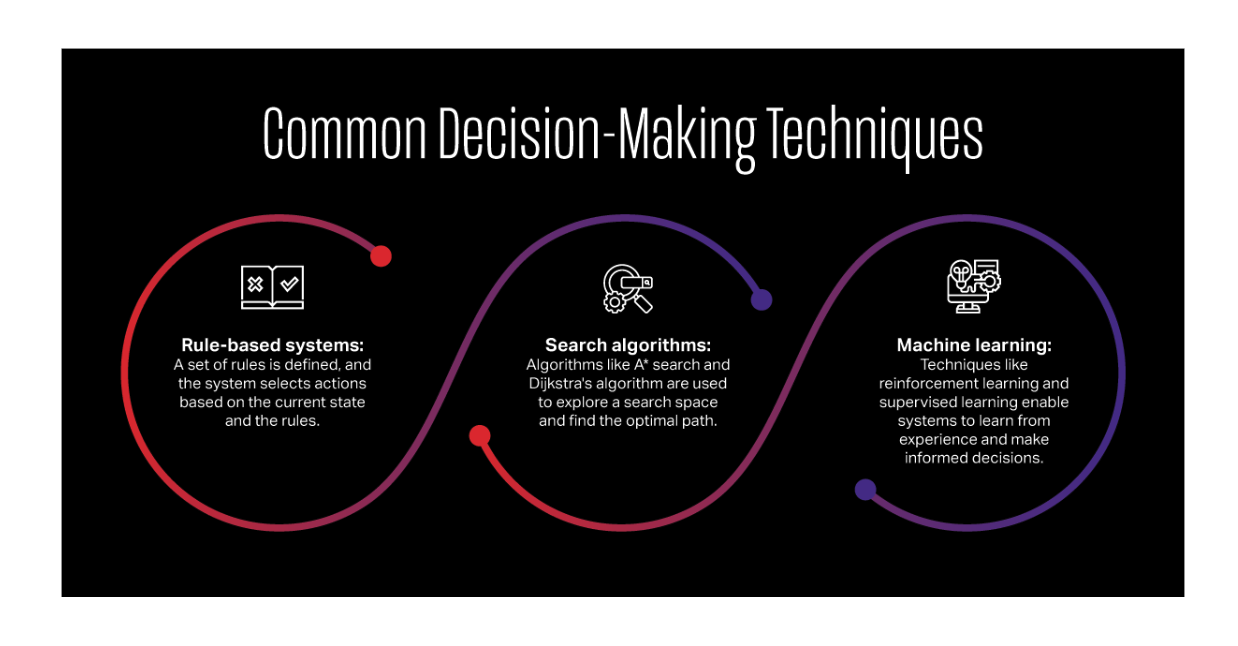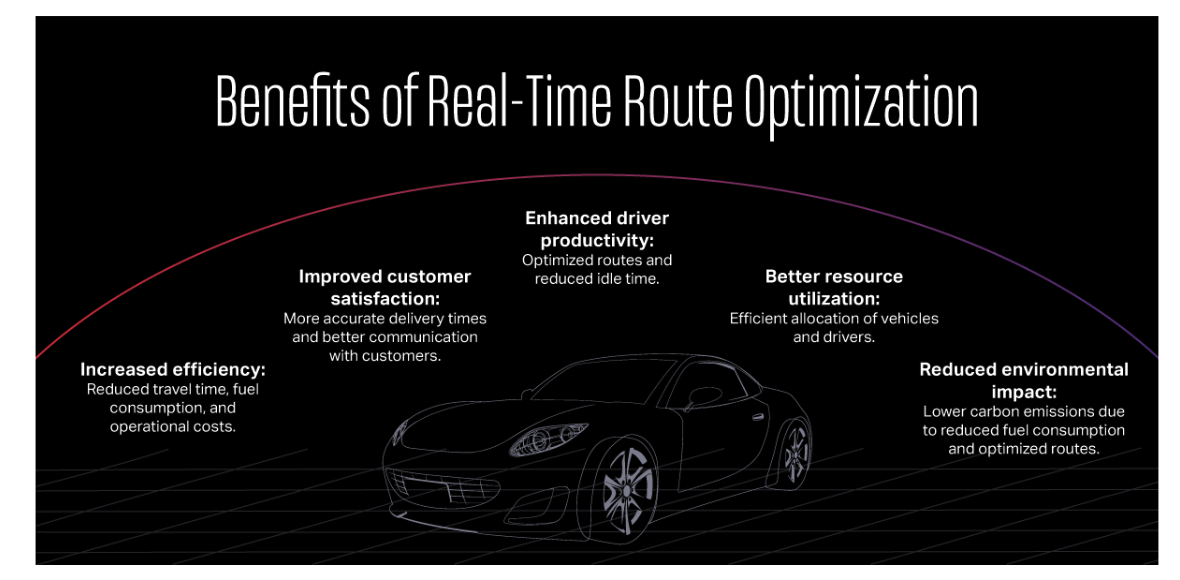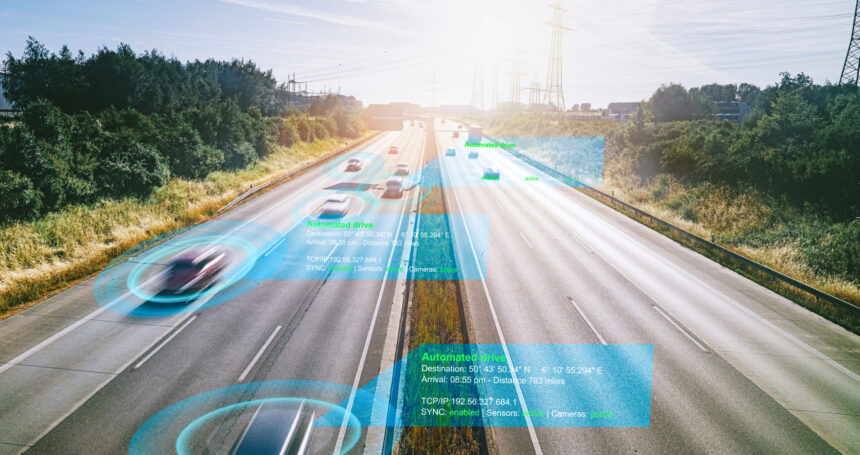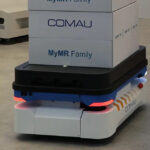As Generative AI and autonomous mobility continue to advance, the focus shifts from foundational applications to exploring deeper technical capabilities and addressing complex challenges. In this part, we delve into advanced topics such as predictive perception, real-time route optimization, and ethical decision-making. These areas highlight the sophisticated interplay between AI, data, and autonomous systems, paving the way for a future where technology meets and exceeds human expectations in safety, efficiency, and reliability.
Scene Understanding
Scene Understanding is a field of artificial intelligence that focuses on enabling computers to interpret and understand visual information from real-world scenes. It involves analyzing images or video frames to identify objects, their relationships, and the overall context of the scene. At iMerit, our expert annotators use Ango Hub’s collaborative workflows to create richly labeled datasets that power advanced scene understanding models, ensuring high accuracy even in complex, dynamic environments typical of autonomous mobility.
Key Components of Scene Understanding
- Object Detection: Identifying and locating objects within a scene, such as people, cars, or buildings.
- Semantic Segmentation: Assigning semantic labels to each pixel in an image, categorizing them into different object classes (e.g., sky, road, car).
- Instance Segmentation: Identifying and segmenting individual instances of objects within a scene, even if they belong to the same class.
- Scene Graph Generation: Construct a graph representation of the scene, where nodes represent objects and edges represent relationships between them.
- Depth Estimation: Estimating the distance of objects from the camera, providing 3D information about the scene.
GenAI for Autonomous Mobility: Applications of Scene Understanding
Autonomous vehicles rely on scene understanding for safe and intelligent driving decisions, identifying hazards, and navigating complex environments. It’s critical for the vehicle to properly perceive and understand its surroundings to safely navigate situations.
1. Predictive Perception
Predictive perception combines sensor data, machine learning, and predictive models to anticipate the behavior of objects in an environment. iMerit supports this with specialized annotation services that include temporal labeling and behavior tagging, managed through Ango Hub. Our human-in-the-loop processes ensure that the predictive models are trained on robust, real-world data that capture subtle cues necessary for anticipating future object movements safely.
Read More: iMerit helped a leading AV company enhance predictive perception by annotating 3D point cloud and LiDAR data
Key Components of Predictive Perception
- Data Collection and Real-Time Processing
Predictive perception relies on data from sensors like LiDAR, radar, and cameras. These sensors capture real-time information about the surroundings, including the position, speed, and direction of objects. This data is then processed using advanced algorithms that identify patterns in the movement of surrounding objects. - Machine Learning and Behavior Modeling
Predictive perception uses machine learning models trained on vast datasets of human driving behavior, road situations, and object interactions. These models help autonomous systems recognize subtle cues, like a pedestrian turning their head towards the road, that indicate possible future actions. Behavior modeling also includes understanding traffic flow, identifying potential hazards, and distinguishing between static and dynamic obstacles.
2. Decision-Making and Path Planning
Decision-making and path planning rely on precise data inputs and continuous model refinement. Using iMerit’s scalable annotation solutions integrated with Ango Hub, clients can efficiently label complex scenarios like lane changes, obstacle avoidance, and route preferences. Our platform enables iterative feedback and quality audits that help improve algorithm reliability in real-time decision making and adaptive path planning.
Decision-Making
It involves selecting the best course of action from a set of options. In the context of autonomous systems, this could mean choosing a specific path, adjusting speed, or reacting to unexpected obstacles.
Common Decision-Making Techniques
- Rule-based systems: A set of rules is defined, and the system selects actions based on the current state and the rules.
- Search algorithms: Algorithms like A* search and Dijkstra’s algorithm are used to explore a search space and find the optimal path.
- Machine learning: Techniques like reinforcement learning and supervised learning enable systems to learn from experience and make informed decisions.

Path Planning
It involves determining a sequence of actions or movements to reach a goal. It’s essential for tasks like navigation, obstacle avoidance, and motion control.
Common Path Planning Algorithms
- A search: A popular algorithm that efficiently explores the search space and finds the shortest path to the goal.
- Dijkstra’s algorithm: Another widely used algorithm, especially for finding the shortest path in graphs with non-negative edge weights.
- RRT (Rapidly-exploring Random Tree): A probabilistic algorithm that efficiently explores the configuration space of a robot.
The synergies between decision making and path planning are often intertwined. For instance, an autonomous vehicle might use a decision-making system to determine whether to change lanes or maintain its current course. Once the decision is made, a path planning algorithm can generate a safe and efficient trajectory to execute the maneuver.
Key Considerations
- Uncertainty: Real-world environments are inherently uncertain. Robust decision-making and path-planning algorithms must be able to handle uncertainty and adapt to changing conditions.
- Computational efficiency: Efficient algorithms are crucial for real-time applications, especially in dynamic environments.
- Safety and reliability: Autonomous systems must prioritize safety. Decision-making and path-planning algorithms should be designed to avoid collisions and other hazards.
By effectively combining decision-making and path-planning techniques, autonomous systems can navigate complex environments, make intelligent choices, and achieve their goals safely and efficiently.
3. Real-Time Route Optimization
As technology continues to advance, real-time route optimization is poised to become even more sophisticated and powerful. By leveraging iMerit’s Ango Hub platform, businesses can seamlessly integrate high-quality annotated data and continuous feedback loops to enhance their route optimization algorithms. This innovative approach not only helps companies gain a competitive edge but also improves operational efficiency and enables them to deliver exceptional customer experiences through smarter, data-driven decisions.
How Does Real-Time Route Optimization Work?
Data Integration
Real-time route optimization relies on advanced algorithms, machine learning, dynamic adjustments, and real-time problem solving, and at the heart of it all is seamless data integration.
- Real-time traffic data: This includes information about traffic congestion, accidents, and road closures.
- Weather updates: Real-time weather data can influence route choices, especially in areas prone to adverse weather conditions.
- Vehicle and driver information: Data on vehicle location, speed, and driver availability is crucial for optimal route planning.
- Customer and delivery information: Details about delivery windows, priorities, and any specific delivery requirements.
Advanced Algorithms
Includes Vehicle Routing Problem (VRP) algorithms and machine learning models to predict traffic patterns
Vehicle Routing Problem (VRP) algorithms are mathematical optimization techniques designed to determine the most efficient routes for multiple vehicles by considering factors such as distance, time, and capacity constraints. Complementing these, machine learning models analyze historical traffic data to predict future traffic patterns and other dynamic factors, enabling real-time adjustments to optimize routing decisions more effectively.
Dynamic Route Adjustments
As conditions change, the system continuously re-optimizes routes to minimize delays and optimize fuel consumption. Drivers receive real-time notifications about route changes, traffic alerts, and potential delays, enabling timely responses and smoother operations.
Proactive problem-solving
The system can identify potential issues and suggest solutions, such as rerouting or reassigning deliveries.
Benefits of Real-Time Route Optimization
- Increased efficiency: Reduced travel time, fuel consumption, and operational costs.
- Improved customer satisfaction: More accurate delivery times and better communication with customers.
- Enhanced driver productivity: Optimized routes and reduced idle time.
- Better resource utilization: Efficient allocation of vehicles and drivers.
- Reduced environmental impact: Lower carbon emissions due to reduced fuel consumption and optimized routes.

Real-World Applications
- Logistics and delivery: Optimizing delivery routes for courier services, food delivery, and e-commerce.
- Field service: Scheduling and routing technicians for maintenance, repair, and installation services.
- Transportation and logistics: Planning efficient routes for trucks, trains, and ships.
- Emergency services: Dispatching emergency vehicles to incidents in the most efficient way.
As technology continues to advance, real-time route optimization is poised to become even more sophisticated and powerful. By embracing this innovative solution, businesses can gain a competitive edge, improve operational efficiency, and deliver exceptional customer experiences.
4. Behavior Prediction of Other Road Users
Predicting human behavior on the road requires comprehensive datasets that reflect diverse, real-world conditions. iMerit contributes by generating rich, multimodal annotations from sensor fusion data, managed and tracked via Ango Hub to support advanced machine learning models. Our domain experts also apply quality controls and edge case analysis, helping autonomous systems better understand and predict pedestrian and cyclist behavior.
Key Challenges and Approaches
Human Unpredictability
- Contextual Factors: Human behavior is heavily influenced by environmental factors, social cues, and individual differences.
- Intentions and Goals: Accurately inferring the intentions of other road users is challenging, as they may have multiple potential goals.
- Emotional State: Emotions can significantly impact decision-making and behavior.
Diverse Road User Behaviors
- Pedestrians: Pedestrians exhibit a wide range of behaviors, from crossing streets to waiting on sidewalks.
- Cyclists: Cyclists often share road space with vehicles and pedestrians, making their behavior even more complex.
Approaches to Behavior Prediction
To address these challenges, researchers and engineers have explored various approaches:
Machine Learning and Deep Learning
- Sensor Fusion: Combining data from multiple sensors (cameras, LiDAR, radar) to perceive the environment accurately.
- Trajectory Prediction: Using deep learning models to predict the future trajectories of road users based on their historical motion patterns and contextual information.
- Intent Recognition: Machine learning techniques are employed to infer the intentions of road users by analyzing their body language, gaze, and other cues.
Behavioral Modeling
- Rule-Based Models: Defining specific rules and conditions to predict behavior, such as traffic laws and social norms.
- Statistical Models: Using statistical methods to analyze historical data and identify patterns in human behavior.
- Hybrid Models: Combining rule-based and statistical models to capture both deterministic and probabilistic aspects of behavior.
Simulation and Virtual Environments
- Creating Realistic Scenarios: Simulating various traffic scenarios to test and refine prediction models.
- Human-in-the-Loop: Involving human participants to provide ground truth data and validate predictions.
Future Directions
- Multimodal Sensor Fusion: Integrating information from diverse sensors to improve perception and prediction accuracy.
- Advanced Deep Learning Techniques: Developing more sophisticated deep learning models to capture complex patterns in human behavior.
- Real-World Data Collection and Annotation: Gathering large-scale datasets of real-world driving scenarios to train and evaluate models.
- Ethical Considerations: Addressing ethical implications, such as privacy concerns and potential biases in AI systems.
By combining these approaches and continuously refining models, researchers aim to develop robust and reliable behavior prediction systems that enhance the safety and efficiency of autonomous vehicles
5. Simulation and Testing
Generative AI is revolutionizing testing by enabling automated, diverse scenario generation. iMerit’s HITL (Human-in-the-Loop) workflows, powered through Ango Hub, ensure that synthetic test cases are validated by experts, maintaining high fidelity and relevance. This combination accelerates simulation cycles, improves test coverage, and ensures autonomous systems perform safely in a broad range of real-world conditions.
Leveraging GenAI for Diverse and Realistic Test Scenarios
Generative AI is revolutionizing the way we approach software testing. By automating the creation of diverse and realistic test scenarios, GenAI significantly enhances test coverage and efficiency.
Key Techniques and Benefits
Automated Test Case Generation
- Machine Learning Algorithms: These algorithms analyze software specifications, requirements, and existing test cases to automatically generate new test cases.
- Enhanced Test Coverage: GenAI can identify and explore edge cases and uncommon scenarios that might be overlooked by human testers.
- Increased Efficiency: Automation reduces manual effort and accelerates the testing process.
Data Generation for Testing
- Synthetic Data Creation: GenAI can generate realistic synthetic data sets to simulate real-world usage scenarios.
- Comprehensive Testing: This enables thorough testing across a wide range of data inputs, uncovering potential vulnerabilities and improving software reliability.
- Privacy and Security: Synthetic data can be used to protect sensitive information while still providing valuable testing data.
Practical Applications
- Unit Testing: Generate diverse input values and expected outputs to test individual code units.
- Integration Testing: Create complex scenarios involving multiple components to assess their interactions.
- System Testing: Simulate real-world user behavior and system load to identify performance bottlenecks and functional issues.
- Security Testing: Generate malicious input to test the system’s security measures and vulnerability detection capabilities.
Challenges and Considerations
- Model Quality: The quality of generated test cases depends on the quality of the training data and the model’s ability to learn complex patterns.
- Human Oversight: Human testers should still be involved to validate and prioritize generated test cases. This is where iMerit thrives.
- Ethical Considerations: Ensure that generated test cases do not introduce bias or discrimination.
Tools and Frameworks
- AI-Powered Test Automation Tools: These tools leverage AI and machine learning to automate test case generation, execution, and analysis.
- Data Generation Frameworks: These frameworks can generate synthetic data sets for testing purposes.
- Custom-Built Solutions: Tailor-made solutions can be developed to address specific testing needs and integrate with existing testing processes.
By harnessing the power of GenAI, organizations can significantly improve the quality and efficiency of their software testing processes. By generating diverse and realistic test scenarios, developers and testers can gain greater confidence in the reliability and security of their applications.
6. Ethical decision-making in complex scenarios
Addressing ethical concerns in AI demands careful curation and ongoing data validation. iMerit’s annotation teams, supported by Ango Hub’s traceability and audit features, help clients maintain transparency and fairness in AI training datasets. Our collaborative platform facilitates bias detection, continuous model review, and human oversight, enabling ethical AI deployment in autonomous mobility.
Key Ethical Considerations
1. Bias and Fairness
- Data Bias: Ensure that the data used to train the AI model is diverse and representative to avoid biased outputs.
- Algorithmic Bias: Regularly audit the AI algorithms to identify and mitigate biases that may lead to unfair outcomes.
- Fairness Metrics: Implement metrics to measure fairness and equity in AI decision-making.
2. Transparency and Explainability
- Model Interpretability: Develop techniques to understand how the AI model arrives at its decisions.
- Transparent Decision-Making: Clearly communicate the role of AI in decision-making processes.
- Human Oversight: Maintain human oversight to ensure accountability and ethical considerations.
3. Privacy and Security
- Data Privacy: Protect sensitive data used to train and operate the AI model.
- Security Measures: Implement robust security measures to prevent unauthorized access and data breaches.
- TISAX Compliance: Align with recognized industry standards like TISAX to ensure secure data handling, especially when dealing with sensitive automotive and mobility-related information.
- Privacy-Preserving Techniques: Utilize techniques to minimize privacy risks while maximizing AI’s capabilities.

4. Accountability and Liability
- Clear Ownership: Establish clear accountability for AI-related decisions and outcomes.
- Liability Framework: Develop legal frameworks to address potential harms caused by AI.
- Ethical Guidelines: Adhere to ethical guidelines and standards for AI development and deployment.
5. Job Displacement and Economic Impact
- Reskilling and Upskilling: Invest in programs to help workers adapt to the changing job market.
- Ethical AI Deployment: Consider the societal impact of AI and strive for equitable distribution of benefits.
6. Environmental Impact:
- Energy Efficiency: Optimize AI models and infrastructure to reduce energy consumption.
- Sustainable AI: Promote the development of AI technologies that minimize environmental harm.
Practical Strategies for Ethical Decision-Making with GenAI
- Human-Centered Design: Involve humans in the design and development process to ensure AI aligns with human values.
- Ethical Impact Assessments: Conduct regular assessments to evaluate the potential ethical implications of AI decisions.
- Collaboration and Partnerships: Work with experts from various fields to address complex ethical issues.
- Continuous Learning and Adaptation: Ethical AI systems must continually evolve in response to new data and shifting societal expectations. This principle is already being explored in fields like robotics, where feedback-driven learning plays a crucial role.
- Transparency and Communication: Be transparent about the limitations and potential biases of AI systems.
By carefully considering these ethical factors and implementing robust strategies, we can harness the power of GenAI to create a more sustainable future.
Conclusion
iMerit’s Generative AI solutions provide essential support for building precise, high-performance AI models by enabling advanced data curation, generation, annotation, and evaluation. These capabilities are critical across industries and are especially impactful in emerging domains like autonomous mobility.
As autonomous systems advance, GenAI plays a central role in predictive perception, behavior modeling, ethical decision-making, and simulation. iMerit addresses these challenges through solutions like synthetic data generation, reinforcement learning with human feedback (RLHF), and rigorous quality auditing — all supported by a strong foundation in domain expertise.
To learn more about how iMerit’s GenAI capabilities power innovation across sectors, visit our Generative AI solutions page.


























